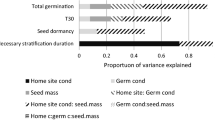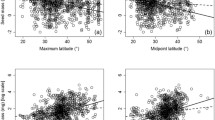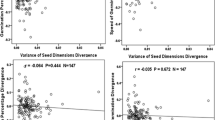Abstract
With increasing elevation, seed mass is expected to be either larger for its advantage during seedling establishment in stressful high-elevation environments (“stress-tolerance” mechanism) or smaller due to energy constraints. Based on the combination of inter- and intra-specific analyses on 4,023 populations of 320 Tibetan plant species, we found an overall positive within species but negative among species seed mass–elevation relationship, suggesting that regional seed mass distribution with elevation is affected mainly by the energy-constraint mechanism at among-species level, but by the stress-tolerance mechanism at within-species level. Moreover, both intra- and inter-specific analyses revealed a mass-dependent seed mass variation along elevation gradients: small seeds tended to increase but large seeds tended to decrease with increasing elevation, indicating that the stress-tolerance (respectively energy-constraint) mechanism may exert a stronger effect on elevational distribution of small-seeded (respectively large-seeded) populations or species. The mass-dependent seed mass variation along elevation gradients, however, was absent within woody and zoochorous species, implying substantial available resources and long time for seed development, and the covariation or coevolution between the mass of zoochorous seeds and their dispersers may allow for a (partial) decoupling of species’ seed mass and their intra-specific variation with elevation. Together our results call for more comparative analyses at different taxonomic levels in detecting geographic variation in a trait.




Similar content being viewed by others
References
Ashton KG (2001) Are ecological and evolutionary rules being dismissed prematurely? Divers Distrib 7:289–295
Ashton KG (2002) Patterns of within-species body size variation of birds: strong evidence for Bergmann’s rule. Glob Ecol Biogeogr 11(6):505–523
Baker G (1972) Seed weight in relation to environmental conditions in California. Ecology 53:997–1010
Bell CD et al (2010) The age and diversification of the angiosperms re-revisited. Am J Bot 97:1296–1303
Blionis GJ, Vokou D (2002) Structural and functional divergence of Campanula spatulata subspecies on Mt Olympos (Greece). Plant Syst Evol 232:89–105
Bolmgren K, Cowan PD (2008) Time–size tradeoffs: a phylogenetic comparative study of flowering time, plant height and seed mass in a north-temperate flora. Oikos 117:424–429
Boulli A et al (2001) Polymorphism of natural populations of Pinus halepensis Mill. in Morocco as revealed by morphological characters. Euphytica 119:309–316
Bu HY et al (2007) Seed mass and germination in an alpine meadow on the eastern Tsinghai-Tibet plateau. Plant Ecol 191:127–149
Coomes DA, Grubb PJ (2003) Colonization, tolerance, competition and seed-size variation within functional groups. Trends Ecol Evol 18:283–291
Cornelissen JHC (1999) A triangular relationship between leaf size and seed size among woody species: allometry, ontogeny, ecology and taxonomy. Oecologia 118:248–255
Du G, Qi W (2010) Trade-offs between flowering time, plant height, and seed size within and across 11 communities of a QingHai-Tibetan flora. Plant Ecol 209:321–333
Fabbro T, Körner Ch (2004) Altitudinal differences in flower traits and reproductive allocation. Flora 199:70–81
Freckleton RP (2009) The seven deadly sins in comparative analysis. J Evol Biol 22:1367–1375
Freckleton RP et al (2002) Phylogenetic analysis and comparative data: a test and review of evidence. Am Nat 160(6):712–726
Geritz SAH (1995) Evolutionarily stable seed polymorphism and small-scale spatial variation in seedling density. Am Nat 146:685–707
Gros A et al (2006) Evolution of local adaptations in dispersal strategies. Oikos 114:544–552
Guo H et al (2010) Geographic variation in seed mass within and among nine species of Pedicularis (Orobanchaceae): effects of elevation, plant size and seed number per fruit. J Ecol 98(5):1232–1242
Hodgson JG, Mackey JML (1986) The ecological specialization of dicotyledonous families within a local flora—some factors constraining optimization of seed size and their possible evolutionary significance. New Phytol 104:497–515
Johnson RA et al (1985) Nutritional values of wild fruits and consumption by migrant frugivorous birds. Ecology 66:819–827
Knight TM et al (2005) Pollen limitation of plant reproduction: ecological and evolutionary causes and consequences. Annu Rev Ecol Evol Syst 36:467–497
Körner Ch (2003) Alpine plant life, 2nd edn. Springer, New York
Leishman MR, Westoby M (1994) Hypotheses on seed size: tests using the semiarid flora of western New Southwales, Australia. Am Nat 143:890–906
Mayr E (1963) Animal species and evolution. Harvard University Press, Cambridge
Moles AT, Westoby M (2003) Latitude, seed predation and seed mass. J Biogeogr 30:105–128
Moles AT, Westoby M (2006) Seed size and plant strategy across the whole life cycle. Oikos 113:91–105
Moles AT et al (2005) Factors that shape seed mass evolution. Proc Natl Acad Sci USA 102:10540–10544
Muller-Landau HC (2010) The tolerance–fecundity trade-off and the maintenance of diversity in seed size. Proc Natl Acad Sci USA 107:4242–4247
Murray BR et al (2004) Geographical gradients in seed mass in relation to climate. J Biogeogr 31:379–388
Pluess AR et al (2005) Seed weight increases with altitude in the Swiss Alps between related species but not among populations of individual species. Oecologia 144:55–61
Qi W et al (2014a) Biological traits are correlated with elevational distribution range of eastern Tibetan herbaceous species. Plant Ecol 215:1187–1198
Qi W et al (2014b) Disentangling ecological, allometric and evolutionary determinants of the relationship between seed mass and elevation: insights from multiple analyses of 1,355 angiosperm species on the eastern Tibetan Plateau. Oikos 123:23–32
Rees M (1997) Evolutionary ecology of seed dormancy and seed size. In: Silvertown J, Franco M, Harper JL (eds) Plant life histories—ecology, phylogeny and evolution. Cambridge University Press, Cambridge, pp 121–142
Smith CC, Fretwell SD (1974) The optimal balance between size and number of offspring. Am Nat 108:499–506
Smith SA et al (2010) An uncorrelated relaxed-clock analysis suggests an earlier origin for flowering plants. Proc Natl Acad Sci USA 107:5897–5902
Sola AJ, Ehrlén J (2007) Vegetative phenology constrains the onset of flowering in the perennial herb Lathyrus vernus. J Ecol 95:208–216
Thompson K, Rabinowitz D (1989) Do big plants have big seeds? Am Nat 133:722–728
Tiffney BH (2004) Vertebrate dispersal of seed plants through time. Annu Rev Ecol Evol Syst 35:1–29
Totland Ø, Eide W (1999) Environmentally-dependent pollen limitation on seed production in alpine Ranunculus acris. Ecoscience 6:173–179
Wang Z et al (2007) Altitudinal patterns of seed plant richness in the Gaoligong Mountains, south-east Tibet, China. Divers Distrib 13:845–854
Westoby M et al (1996) Comparative ecology of seed size and dispersal. Philos Trans R Soc B 351:1309–1318
Acknowledgments
We thank Dr. Xuelin Chen, Yifeng Wang, Hui Guo, Kun Liu, Xianliang Cui, Xin Yin, Min Yang and Mei Su for their help with field work. The study was supported by the Project of the National Natural Science Foundation of China granted to Haiyan Bu (41171046), Guozhen Du (41430749, 41171214) and Juhong Wang (31470021), and the Fundamental Research Funds for the Central Universities granted to Wei Qi (lzujbky-2014-94) and Xianhui Zhou (lzujbky-2013-100).
Author information
Authors and Affiliations
Corresponding author
Additional information
Communicated by Jennifer Lee Firn.
Electronic supplementary material
Below is the link to the electronic supplementary material.
11258_2014_435_MOESM1_ESM.xls
List of 320 species used in the analysis and their functional traits. Ele, elevation; SM, seed mass; LF, life form; DM, dispersal mode; Poll, Pollination system. Abbreviations of Th, Hp, Wp, Ane, Auto, Ecto, Endo, An and En are as specified in Fig. 2. (XLS 518 kb)
Rights and permissions
About this article
Cite this article
Qi, W., Bu, H., Cornelissen, J.H.C. et al. Untangling interacting mechanisms of seed mass variation with elevation: insights from the comparison of inter-specific and intra-specific studies on eastern Tibetan angiosperm species. Plant Ecol 216, 283–292 (2015). https://doi.org/10.1007/s11258-014-0435-7
Received:
Accepted:
Published:
Issue Date:
DOI: https://doi.org/10.1007/s11258-014-0435-7




